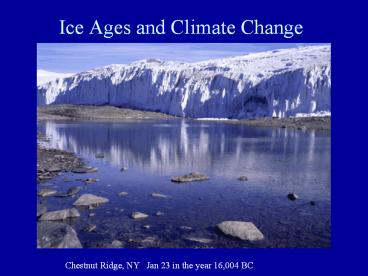Ice Ages and Climate Change - PowerPoint PPT Presentation
1 / 46
Title:
Ice Ages and Climate Change
Description:
Ice Ages and Climate Change. Chestnut Ridge, NY Jan 23 in ... paleontologist at the Swiss Academy. of Natural Sciences. In 1837 he proposed that the presence ... – PowerPoint PPT presentation
Number of Views:75
Avg rating:3.0/5.0
Title: Ice Ages and Climate Change
1
Ice Ages and Climate Change
Chestnut Ridge, NY Jan 23 in the year 16,004 BC
2
Four questions of climate change
- What are ice ages?
- How do we know there were ice ages, and when did
- they occur in the past?
- How do we get an ice age?
- What can we expect in the future?
3
How do we know there were ice ages?
4
Modern Climate Records
What is climate anyway? -Weather average gt30
years Central England Air Temperature
1659-Present What other records are there?
5
Historical Records of Climate
Painting of Winter on the frozen Thames River,
London
Grove, 1988
6
Agricultural Records
- Ripening of grapes depends strongly on climate
- Cold years delay harvest date
7
Geologic records of climate
- Land-based evidence of glaciers
- 2. Deep sea sediments
- 3. Present ice sheets
8
Land Records Moraines
9
Glacial Erratics
Some rocks have been transported far enough by
glaciers that they no longer look like nearby
bedrock
10
Glacial depositsin areas notcurrently glaciated
Laurentide ice sheet 18,000 years ago
11
Louis Agassiz
A Swiss zoologist and paleontologist at the
Swiss Academy of Natural Sciences In 1837 he
proposed that the presence of moraines and
erratics were evidence that glaciers once existed
where they are no longer found today. and the
science of reconstructing ancient climate was
born!
12
Evidence for more than one ice age!
Cant we get any more detailed than this?
Penck and Brueckner, 1909
13
Climate records from the oceanSediment cores
These are vertical sections of mud and
sand taken from the ocean floor. Everything that
lives in the ocean eventually winds up on the
sea floor Fine clay and the sand-sized skeletons
of plankton make up most of the material on the
sea floor.
14
Ocean Sediment Cores
Cores at Deep Sea Sample Repository at
Lamont-Doherty Observatory
15
What is in a sediment core?
Sand grains of quartz and other minerals.
Volcanic ash from local eruptions.
Plus clay, clay and more clay!
Bond et al. (1997)
16
Shells of single-celled organisms called
Foraminifera
17
Why are ocean sediment cores great climate
records?
- They are continuous records
- They are datable by a variety of techniques
- They are available for many time periods
- They can be very detailed!
18
Chemistry of foraminifera in marine sediments
depends on water temperature!
Emiliani, 1955
19
800,000 years of glacial cycles
This is from marine sediment cores
20
Climate of the last 2.5 million years
21
Ice Cores
Sections of ice from the Antarctic Ice Sheet
provide a climate record stretching back to
420,000 years.
22
Ice Ages are Global
Both northern and southern ice sheets experienced
glacial cycles SIMULTANEOUSLY.
23
How do we get an ice age?
Before we can answer this question, we must
know Why is the temperature of the Earth what
it is?
24
What determines Earths temperature?
- The balance between incoming and outgoing solar
energy - The Greenhouse Effect keeps Earths temperature
livable.
25
Carbon dioxide matches glacial cycles!
26
Solar radiation and glacial cycles
27
Ice Sheets, the key to ice ages
Ice sheets can CAUSE global climate change
1. Bright ice reflects solar radiation, leading
to cooling and more ice growth. 2. Cooling the
ocean surface causes it to absorb Carbon Dioxide
(CO2). Carbon dioxide is one of the most
important gases that create the greenhouse
effect. Scientists have reasoned that it is
possible to cause a global ice age by building
an ice sheet in northeastern Canada. These are
called climate FEEDBACK MECHANISMS
28
How on Earth do you build an ice sheet?
29
Changes in the Earths orbit
Minimize summer warmth to promote ice sheet
growth!
30
What about future ice ages?
31
Changes in the greenhouse effect may result from
industrial activity
32
Can climate change happen quickly?
- Many places are warmed by
- ocean currents
- If these warm ocean currents
- were diverted or shut off,
- the eastern US and Europe
- would cool
33
Great Ocean Conveyor
34
What controls recent climate?The Sun!
Black Climate in the North Atlantic
region Blue Solar activity
35
(No Transcript)
36
to summarize
1. Global ice ages have come and gone regularly
for almost 3 million years. 2. Geologic
records such as sediment cores reveal climate
history 3. Formation of large ice sheets is
necessary to cause global cooling 4. Changes in
the seasonal input of solar energy allow ice to
grow 5. Ice ages may happen in the future, but
changes in the atmosphere caused by humans may
alter the timing. 6. Small but important climate
change may happen quickly. Understanding how
climate works on short time scales is the major
goal of current research.
37
(No Transcript)
38
Ice ages and human migration
Matsch, 1976
Lister and Bahn, 1994
39
(No Transcript)
40
(No Transcript)
41
(No Transcript)
42
Annual layers in ancient records
43
Ice extent during peak of last glacial period
44
What determines Earths temperature?
45
Where do you find interesting cores?
RV Maurice Ewing, of Columbia University
Ships track from a voyage in 1998.
46
Solar energy reaching a point on Earth varies
through time
Laskar 1993 data set































